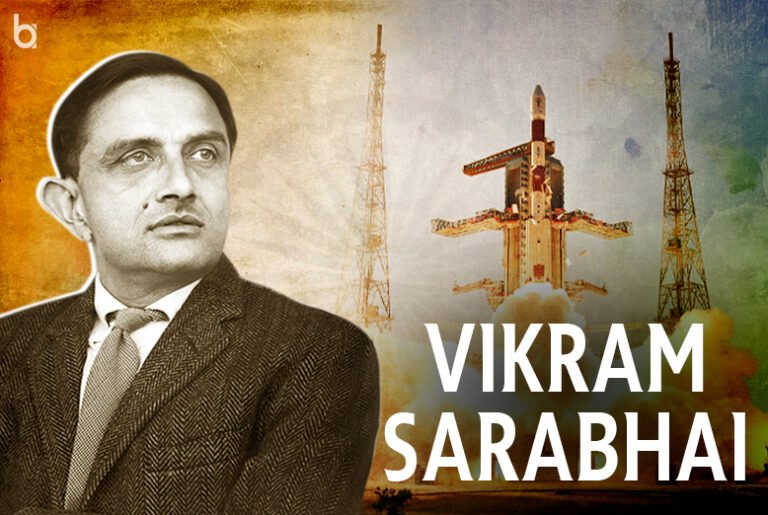Vikram Sarabhai is regarded as one of India’s greatest visionaries because of his illustrious career in science, space, and national development. The “Father of the Indian Space Program,” Sarabhai was not just a scientist but one who felt that technology could offer a hand to the masses. Together with his concepts and efforts, he has put in place the very pillar of ISRO, the space agency to be most recognized in the world. But that’s not all he did.
Sarabhai was a teacher, entrepreneur, and philanthropist; his legacy can be witnessed in Indian science to date. His work still empowers a future generation of youngsters who enter this field as an inheritance from him. This is only a small piece of Bio Vikram Sarabhai, a life and work chronicle who will remain bright before future generations.
Key Stats and Milestones of Vikram Sarabhai: The Father of India’s Space Program
| No. | Stats | Detail |
| 1 | Full Name | Vikram Ambalal Sarabhai |
| 2 | Date of Birth | August 12, 1919 |
| 3 | Place of Birth | Ahmedabad, Gujarat, India |
| 4 | Death | December 30, 1971 (Aged 52) |
| 5 | Field of Work | Space Science, Physics, Technology, Education, Entrepreneurship |
| 6 | Notable Title | “Father of the Indian Space Program” |
| 7 | Key Organization Founded | Indian Space Research Organisation (ISRO) – 1969 |
| 8 | Other Institutions Founded | Indian Institute of Management (IIM), Ahmedabad (1961); Vikram Sarabhai Space Centre (VSSC) |
| 9 | First Major Satellite Launched by India | Aryabhata (1975): Launched by the Soviet Union |
| 10 | Space Launch Vehicle Developed | SLV (Satellite Launch Vehicle): First successful satellite launch in 1980 |
| 11 | Signature Achievements | Played a critical role in establishing India’s first space center (VSSC), developing remote sensing satellites, and pushing for space technology in national development |
| 12 | Educational Background | B.A. in Natural Sciences from the University of Cambridge, Ph.D. in Physics from Caltech |
| 13 | Major Contributions Beyond Space | Advocated for the development of science and technology in India and contributed to management education through IIM Ahmedabad |
| 14 | Philosophy on Space | Believed that space technology should primarily serve the needs of developing nations, especially in improving the quality of life in areas like agriculture, communication, and healthcare |
| 15 | International Collaborations | Fostered cooperation with global space agencies and scientists, including the Soviet Union and NASA |
Early life and education
Vikram Ambalal Sarabhai was born on August 12, 1919, in Ahmedabad, Gujarat, into a prominent family of industrialists. His father, Ambalal Sarabhai, was a big-time businessman and philanthropist, while his mother, Sarla Devi, has a highly educated, intellectual background. Sarabhai was raised in a rich intellectual climate; his family promoted learning and curiosity from a very young age.
Sarabhai obtained his elementary education from the prestigious Gujarat College at Ahmedabad Elementary. Yet his educational trajectory was diverted drastically when he pursued higher studies in another nation. He studied at the University of Cambridge for a degree in natural sciences.
He later proceeded to the California Institute of Technology (Caltech), USA, and got a Ph.D. in physics. This was the beginning of his interest in astronomy and space science fields, which would later become his life passion.
A Visionary Scientist and Entrepreneur
Sarabhai with both patriotism and scientific intellect, found perfect harmony in blending science and business when he returned to India. He had been trained in robotics by a great many scientists of his time; unlike many other scientists at that time, he did not see technology as being some pretty tool but rather as a means to make societal progress. Science & Technology: His pioneering work in science was not restricted to white-lab coats; he was also a great defender of scientific research, technology, and education in India.
Sarabhai was a founder of most of the research and educational institutions, the most notable being the Indian Institute of Management (IIM) Ahmedabad, founded in 1961. No one could emphasize more the need for management education to flourish as Indian industries do.
His other key innovation was in the setup of ISRO—Indian Space Research Organisation. In the early 1960s, the Indian government was trying to embed space technology into the national development model.
The Birth of ISRO
Apart from Vikram Sarabhai’s efforts, there were no actual space infrastructures in India before his efforts. As a vision, Sarabhai wanted to use space technology for real societal problem-solving (communication, weather forecasting, and resource mapping) as much as possible that could help with India’s socioeconomic development.
In 1962, under the Department of Atomic Energy, Sarambhai started the Indian National Committee for Space Research (INCOSPAR). One of his most important undertakings during this period was establishing the Thumba Equatorial rocket launch station in Kannur, which was India’s first launch site for sounding rockets in 1963. He wanted India but not other nations to use the emerging technologies on a priority basis for their needs instead of trends.
Sarabhai’s most pioneering move was in 1969, when he created the Indian Space Research Organisation (ISRO) by starting dreams of making India a superpower in space. Instead, its true purpose when founded was not to be a superpower-space competitor but rather technology development to help the Indian economy and uplift lives, as simply said, “The poverty of excellence.
He imagined one that would not only look to the cosmos but also drive reforms in education, health, and connectivity for rural India.
Significant Milestones
Some of the major accomplishments by ISRO under the leadership of Sarabhai. The following are some of the significant developments that have happened:
- Aryabhatta (1975): Aryabhatta, India’s First Satellite, was launched into space by the Soviet Union to mark the entry of India into space; though Vikram Sarabhai passed away before this momentary achievement, his spirit was fulfilled with Aryabhatta becoming a landmark in space aspirations for India.
- SLV (Satellite Launch Vehicle): After all, the development of an Indian satellite launch vehicle that would orbit its own for the country was one of the key contributions of Sarabhai. India’s first successful launch (1980) carrying the Rohini satellite into orbit showcased the growing thrust of ISRO, and thus India made its presence felt in the era of space.
- Space Science and Satellite Programs: Right from his vision to utilize space technology for application. His vision resulted in the development of communication satellites that have greatly improved rural communication, television broadcasts, etc. in India.
- Development of Indian Remote Sensing Satellites: He contributed a lot to the development of space technology not just for science-related experiments but also applied to monitor and govern resources, making way for remote sensing satellites in agriculture and environmental platforms.
Sarabhai Space Technology Philosophy
Sarabhai did not see space technology for its own sake but as a step towards something great. To him, space technology was not a vehicle of military/geopolitical competition but a device to enable the uplift of our people in India. He particularly thought that the scientific elements in national projects are very relevant to Indian needs and aspirations. His phrase, ‘Space technology is not just for the advanced nations; it is for the developing countries to improve the quality of life’; they want the high quality of life through this technology’, is an excellent representation of this philosophy.
Apart from all this, Sarabhai also had a different leadership pattern. He loved to interact; he was often seen as a motivating force for the scientists at ISRO and not just a technical mentor but an inspirational leader to kindle their sense of nationalism and duty. He was a strong proponent of the scientific aspect of international space research and that knowledge would be a blessing in the development of mankind.
Vikram Sarabhai Space Centre (VSSC)
The Space Centre of Vikram Sarabhai is one of the space technology pioneers who left behind the Vikram Sarabhai Space Centre (VSSC), Thiruvananthapuram, Kerala. Founded in 1963 as Thumba Equatorial Rocket Launching Station (TERLS), it was later renamed after Sarabhai for his well-known contribution to the Indian space program, in memory of him as he breathed his last.
VSSC has, is, and will continue to play a significant role in India’s early space era and is still the key institution for research, development & testing of space technology The center has always been a backbone in efforts to develop satellites, launch vehicle technology and several other vital space missions of India. This is where India’s very first indigenous satellite launch vehicle (SLV-3) was born.
Since it is one of the focal points to do various successful space missions orbit development and expert of ISRO on all its future advancements over there. VSSC is not only a symbol of India but also the symbol of the vision of Sarabhai that space technology should be essential to the nation.
Family and Legacy
Apart from his scientific work, Sarabhai was a truly spiritual and intellectual person. He is married to Marnilini Sarabhai, an iconic classical dancer, and they have two children. Sarabhai was a well-rounded individual with a taste for art and culture as well as literature, and he wanted his children to have that blend of education too. Sarabhai may have done a lot, but the man achieved so much as never forgetting his humble beginnings and putting the sake of his country before personal accolades.
Vikram Sarabhai died very suddenly in 1971 at the age of 52, leaving his many contributions to India. But his accomplishments are enshrined in the institutions he bequeathed and the advances he made in space science. His eternal devotion to the future of India’s space program created a platform for future success and made ISRO one of the topmost agencies in space around the world today.
Conclusion
The Vikram Sarabhai biography has left an indelible mark on India. His dream of a self-reliant India where advanced space technologies would be harnessed for the good of the country defined its destiny. Today ISRO is one of the most successful and loved space agencies in the world, all because of Sarabhai and his team working for it.
Sarabhai lives to be an eternal inspiration to others through his example of vision, passion, and a lot more hard work. Everyone can do great things. His faith in the transformative power of science, technology, and education echoes much today and thus he is no less than a national icon for science or progress.
The legacy of Vikram Sarabhai is a lot more than rockets and satellites; it serves as testimony that the pursuit of knowledge and the urge for good of mankind should not be distinct. He has imposed a grand and lasting impression on science and his contemporaries.



